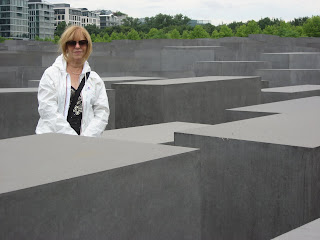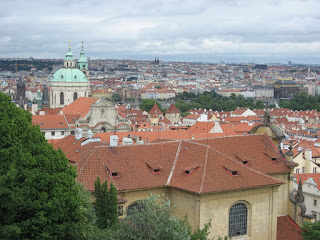Day 6: Budapest and Szentendre
Waking bleary eyed after a few hours of sleep, we headed off for a tour of the Hungarian parliament. It is an amazingly ornate and impressive building. A tour guide led us up a long flight of stairs to the center of the building where we visited the "Crown Jewels" guarded at all times by Hungarian guards. We then walked down the hallway to the parliament, which seats 368 (I believe). It is a right wing government that rules with a large majority, joined by two even more extreme right wing groups ... including a fascist group that holds 13% of the vote.
Each step of the way we were followed by plain clothed security that made sure we stayed together ... commanding us to keep up with the group, should we stop to take a picture.
While truly impressive there was also something strangely ominous about all of this. I had an uncomfortable feeling that it was not easy to shake. Perhaps it is the grandiosity of the building itself? Perhaps the plain clothed security following us around? Perhaps the right wing government that, as our tour guide Anni would tell us later, was already invoking measures and making speeches that reminded her parents of 1938.
Anti-semitism, it seems, is never far from the surface ... even here, in the country in which the Jews were probably the safest. Of course, following the viscous anti-semitism of Nazi Germany, there was the more tolerant, but also oppressive anti-semitism of the communist era. And now, there is anti-semitism arising from blame being placed on the Jews for the 40 years of communist rule! (Believe it or not ... after all, Karl Marx was a Jew ...)
Of course, when we returned to the bus and to Anni we learned what had not been mentioned by our Parliament guide, that the buildings architect was Jewish. The hidden, unrecognized contributions of Jews to Budapest is truly amazing. And what would become clear later, is just how frustrating this is to Anni ... not only that it goes unrecognized, but that the Jewish community is unwilling to stand up and ask for that official recognition.
Well, following our tour of Parliament we took off for the Castle District, for a quick tour of the Buda hilltop where this city began ... as a castle, cathedral and fortress.

After a brief visit we headed off towards the small artist colony of Szentendre. But on the way, we stopped for a brief visit to the Raoul Wallenberg memorial, located in a lovely park in the "Rose Hill" area of Buda, which was ... and still is today ... the traditional Jewish neighborhood of Budapest.

Today, about 80,000 Jews live in Budapest, the third largest Jewish city in Europe following London and Paris. On the way to lunch and the artist colony of Szentendre I had the opportunity to discuss the demographics of the Jewish community with Anni. She noted that it is hard to tell just who is who and who belongs to what. No one, she said, would 'join' a synagogue. After all, that is how the Jews were rounded up by the Nazis ... by reviewing synagogue lists. So, people anonymously support causes and Jewish programs of interest, but often, making sure that their names are not published, recorded, etc. There is also little trust in the Jewish Federation of the community, which is still seen as a corrupt institution from the communist era, that can not be trusted to appropriately handle the funds contributed to it. Rather, the respected organization in the community is the Joint Distribution Committee, run, Anni pointed out, by Americans and Israelis.
Arriving at Szentendre we made our way through winding narrow streets and alleys to the most marvelous of restaurants, "The Golden Dragon". Now in America such a place would automatically mean, "Chinese". But don't be fooled this was exquisitely prepared Hungarian cuisine in what is billed as the first privately owned restaurant in Hungary. (Opening in 1977)

This "light" lunch, as Anni called it, consisted of a starter salad with mozzarella and assorted salamis, a beef broth soup with noodles, beef, vegetables and a quail egg. This was followed by a goose breast prepared in a sweet au jus with sesame seeds, delicious mashed potatoes and sweet red cabbage. Finally dessert, which I can only describe as a warm "matzah ball" of sweet cheese smothered in an amazing strawberry sauce. Then to top it off ... espresso. All I can say is 'wow'.

We rolled out of the restaurant and made our way to the 'smallest synagogue' in the world. Indeed the 14 of us plus Anni barely fit into the place. It is impossible to relate the entire story here, but, Anni began to weave a most emotional story about the difficulties of the final months of world war two, the loss of the members of this small Jewish community and the building of this little synagogue as a memorial to them. Only at the end of the story did we come to learn that this was not just any story, this was our tour guide Anni's story ... and this synagogue was her synagogue built by her and other family members in memory of her family and the other lost members of this community. (Which, by the way, included a great uncle who founded Herend ... the well known Hungarian porcelain manufacturer.)
We then wandered the streets finding all sorts of treasures to bring home and boarded a boat to cruise back up to our Hotel on the 'blue Danube", which Anni noted, she has never seen blue!
Another lengthy day ended with a memorial service and reflection at 'The Line of Shoes". On a high levee on the banks of the Danube, just a block from the Parliament is a memorial created by a non-Jew to the Jewish victims who were murdered by the Arrow Cross, a Hungarian pro-Nazi group in the final days of the war. 30 pairs of shoes, old, tattered and worn stand in silent testimony to what happened in this place in the winter of 44-45. Here, Jews from the ghetto, randomly selected were brought. They were ordered to remove their shoes and then a line of 10 or 15 was bound together with rope or wire. As bullets were becoming scarce at the end of the war this war their evilly genius solution ... all bound together, one Jew would be shot. As he fell off the levee 15 or 20 feet into the freezing cold water of the Danube, the rest of the group, would be pulled in with him. Many died instantly from the shock of the icy water, or succumbed to hypothermia as they floated as a group down the river.

Thankfully, down the river, there were those who would attempt to pull them out. In this way, a few were saved from this evil scheme, including the elderly woman from whom we had bought beautiful Judaic treasures the day before.
For the third time we joined together in memorial and recited kaddish for our precious people. Here, Anni noted, quite emotionally was an example of the problem that pained her so .... the memorial plaque at this place speaks of the murdered victims. Conspicuously missing is the word "Jew". When she asked the artist why this was the case he responded, "The Jewish community didn't want it there." The Jews of Budapest, she noted are afraid to speak up ... and the official Hungarian community is unwilling to acknowledge that this was, in particular, a Jewish tragedy. She noted the lack of official Hungarian participation in the memorial plaques at Dachau, where every other European country is listed. Why? and what will happen when there are none left to explain that ALL the victims remembered in the Line of Shoes Memorial were Jews? Not just generic Budapest citizens.
We then spent a few moments in reflection about this first week ... all that we had encountered and all that we had experienced.
What an incredibly packed couple of days! We headed back for dinner and to pack and prepare for a 5a.m. wake up call to catch a flight out of Budapest and on to Prague.




















































